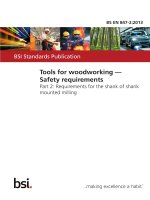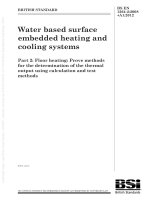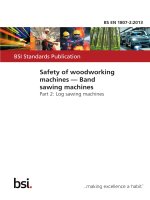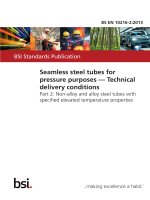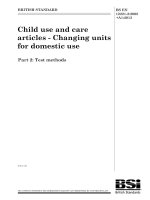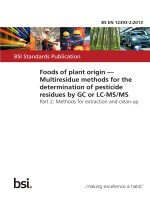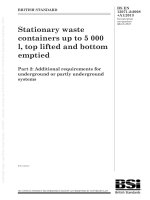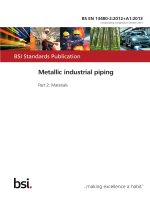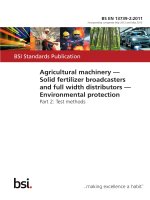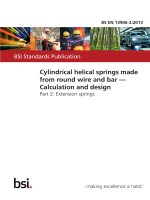Bsi bs en 61558 2 14 2013
Bạn đang xem bản rút gọn của tài liệu. Xem và tải ngay bản đầy đủ của tài liệu tại đây (1.15 MB, 26 trang )
BS EN 61558-2-14:2013
BSI Standards Publication
Safety of transformers,
reactors, power supply
units and combination
thereof
Part 2-14: Particular requirements
and tests for variable transformers
and power supply units incorporating
variable transformers
BRITISH STANDARD
BS EN 61558-2-14:2013
National foreword
This British Standard is the UK implementation of EN 61558-2-14:2013. It is
identical to IEC 61558-2-14:2012.
The UK participation in its preparation was entrusted to Technical Committee
PEL/96, Small transformers.
A list of organizations represented on this committee can be obtained on
request to its secretary.
This publication does not purport to include all the necessary provisions of a
contract. Users are responsible for its correct application.
© The British Standards Institution 2013
Published by BSI Standards Limited 2013
ISBN 978 0 580 53172 9
ICS 29.180
Compliance with a British Standard cannot confer immunity from
legal obligations.
This British Standard was published under the authority of the Standards
Policy and Strategy Committee on 31 March 2013.
Amendments issued since publication
Amd. No.
Date
Text affected
BS EN 61558-2-14:2013
EN 61558-2-14
EUROPEAN STANDARD
NORME EUROPÉENNE
EUROPÄISCHE NORM
March 2013
ICS 29.180
English version
Safety of transformers, reactors, power supply units
and combination thereof Part 2-14: Particular requirements and tests for variable transformers
and power supply units incorporating variable transformers
(IEC 61558-2-14:2012)
Sécurité des transformateurs, bobines
d’inductance, blocs d’alimentation
et des combinaisons de ces éléments Partie 2-14 : Exigences particulières et
essais pour les transformateurs variables
et les blocs d’alimentation incorporant des
transformateurs variables
(CEI 61558-2-14:2012)
Sicherheit von Transformatoren, Drosseln,
Netzgeräten und deren Kombinationen Teil 2-14: Besondere Anforderungen und
Prüfungen für Stelltransformatoren
und Netzgeräte, die Stelltransformatoren
enthalten
(IEC 61558-2-14:2012)
This European Standard was approved by CENELEC on 2012-12-27. CENELEC members are bound to comply
with the CEN/CENELEC Internal Regulations which stipulate the conditions for giving this European Standard
the status of a national standard without any alteration.
Up-to-date lists and bibliographical references concerning such national standards may be obtained on
application to the CEN-CENELEC Management Centre or to any CENELEC member.
This European Standard exists in three official versions (English, French, German). A version in any other
language made by translation under the responsibility of a CENELEC member into its own language and notified
to the CEN-CENELEC Management Centre has the same status as the official versions.
CENELEC members are the national electrotechnical committees of Austria, Belgium, Bulgaria, Croatia, Cyprus,
the Czech Republic, Denmark, Estonia, Finland, Former Yugoslav Republic of Macedonia, France, Germany,
Greece, Hungary, Iceland, Ireland, Italy, Latvia, Lithuania, Luxembourg, Malta, the Netherlands, Norway, Poland,
Portugal, Romania, Slovakia, Slovenia, Spain, Sweden, Switzerland, Turkey and the United Kingdom.
CENELEC
European Committee for Electrotechnical Standardization
Comité Européen de Normalisation Electrotechnique
Europäisches Komitee für Elektrotechnische Normung
Management Centre: Avenue Marnix 17, B - 1000 Brussels
© 2013 CENELEC -
All rights of exploitation in any form and by any means reserved worldwide for CENELEC members.
Ref. No. EN 61558-2-14:2013 E
BS EN 61558-2-14:2013
EN 61558-2-14:2013
-2-
Foreword
The text of document 96/395/FDIS, future edition 1 of IEC 61558-2-14, prepared by IEC/TC 96
"Transformers, reactors, power supply units and combination thereof" was submitted to the
IEC-CENELEC parallel vote and approved by CENELEC as EN 61558-2-14:2013.
The following dates are fixed:
•
latest date by which the document has
to be implemented at national level by
publication of an identical national
standard or by endorsement
(dop)
2013-09-27
•
latest date by which the national
standards conflicting with the
document have to be withdrawn
(dow)
2015-12-27
This standard is to be used in conjunction with EN 61558-1:2005 + A1:2009.
This part supplements or modifies the corresponding clauses in EN 61558-1, so as to convert that
publication into the EN standard: Particular requirements and tests for variable transformers and
power supply units incorporating variable transformers.
A list of all parts of the EN 61558 series, under the general title: Safety of transformers, reactors,
power supply units and combination thereof, can be found on the CENELEC website.
Future standards in this series will carry the new general title as cited above. Titles of existing
standards in this series will be updated at the time of the next edition.
Where a particular subclause of Part 1 is not mentioned in this part, that subclause applies as far as is
reasonable. Where this part states "addition", "modification" or "replacement", the relevant text of
Part 1 is to be adapted accordingly.
In this part, the following print types are used:
– requirements proper: in roman type;
– test specifications: in italic type;
– explanatory matter: in smaller roman type.
In the text of this part, the words in bold are defined in Clause 3.
Subclauses, notes, figures and tables additional to those in Part 1 are numbered starting from 101;
supplementary annexes are entitled AA, BB, etc.
Attention is drawn to the possibility that some of the elements of this document may be the subject of
patent rights. CENELEC [and/or CEN] shall not be held responsible for identifying any or all such
patent rights.
This standard covers the Principle Elements of the Safety Objectives for Electrical Equipment
Designed for Use within Certain Voltage Limits (LVD - 2006/95/EC).
Endorsement notice
The text of the International Standard IEC 61558-2-14:2012 was approved by CENELEC as a
European Standard without any modification.
In the Bibliography of EN 61558-1:2005, the following notes have to be added for the standards
indicated:
IEC 60076-11
NOTE
Harmonised as EN 60076-11.
IEC 61558-2-16
NOTE
Harmonised as EN 61558-2-16.
-3-
BS EN 61558-2-14:2013
EN 61558-2-14:2013
Annex ZA
(normative)
Normative references to international publications
with their corresponding European publications
The following documents, in whole or in part, are normatively referenced in this document and are
indispensable for its application. For dated references, only the edition cited applies. For undated
references, the latest edition of the referenced document (including any amendments) applies.
NOTE When an international publication has been modified by common modifications, indicated by (mod), the relevant EN/HD
applies.
Annex ZA of EN 61558-1:2005 is applicable except as follows:
Publication
Year
Title
EN/HD
Year
EN 61558-1
+ corr. August
+ A1
2005
2006
2009
In Annex ZA of EN 61558-1:2005 add:
IEC 61558-1
+ corr. March
+ corr. March
+ corr. April
+ A1
2005
2010
2008
2011
2009
Safety of power transformers, power
supplies, reactors and similar products Part 1: General requirements and tests
–2–
BS EN 61558-2-14:2013
61558-2-14 © IEC:2012
CONTENTS
1
Scope ............................................................................................................................... 6
2
Normative references ........................................................................................................ 8
3
Terms and definitions ....................................................................................................... 8
4
General requirements ....................................................................................................... 9
5
General notes on tests ...................................................................................................... 9
6
Ratings ........................................................................................................................... 10
7
Classification .................................................................................................................. 10
8
Marking and other information ......................................................................................... 10
9
Protection against electric shock ..................................................................................... 12
10 Change of input voltage setting ....................................................................................... 12
11 Output voltage and output current under load .................................................................. 12
12 No-load output voltage .................................................................................................... 12
13 Short-circuit voltage ........................................................................................................ 14
14 Heating ........................................................................................................................... 15
15 Short circuit and overload protection ............................................................................... 15
16 Mechanical strength ........................................................................................................ 15
17 Protection against harmful ingress of dust, solid objects and moisture ............................. 16
18 Insulation resistance, dielectric strength and leakage current .......................................... 16
19 Construction ................................................................................................................... 16
20 Components ................................................................................................................... 20
21 Internal wirings ............................................................................................................... 20
22 Supply connection and other external flexible cables or cords .......................................... 20
23 Terminals for external conductors ................................................................................... 20
24 Provision for protective earthing ...................................................................................... 20
25 Screws and connections ................................................................................................. 21
26 Creepage distances, clearances and distances through insulation ................................... 21
27 Resistance to heat, fire and tracking ............................................................................... 21
28 Resistance to rusting ...................................................................................................... 21
Annexes ................................................................................................................................ 22
Bibliography .......................................................................................................................... 23
Table 101 – Output voltages difference for auto transformers, separating and safety
isolating transformers ............................................................................................................ 14
Table 102 – Output voltages difference for isolating transformers .......................................... 14
Table 103 – Maximum permitted temperatures of the winding ................................................ 15
BS EN 61558-2-14:2013
61558-2-14 © IEC:2012
–6–
SAFETY OF TRANSFORMERS, REACTORS,
POWER SUPPLY UNITS AND COMBINATION THEREOF –
Part 2-14: Particular requirements and tests for variable transformers
and power supply units incorporating variable transformers
1
Scope
Replacement:
This part of IEC 61558 deals with safety of variable transformers for general applications and
power supply units incorporating variable transformers for general applications.
Transformers incorporating electronic circuits are also covered by this standard.
NOTE 1
Safety includes electrical, thermal, mechanical and chemical aspects.
Unless otherwise specified, from here onward, the term transformer covers variable
transformers for general applications and power supply units incorporating variable
transformers for general applications.
The rated supply voltage does not exceed 1 000 V a.c., and the rated supply frequency
does not exceed 500 Hz.
This standard is applicable to transformers and power supply units (linear) with internal
operational frequencies not exceeding 500 Hz.
This standard used in combination with Part 2-16 for switch mode power supply units
(SMPS) is also applicable to power supplies with internal operational frequencies higher than
500 Hz. Where the two requirements are in conflict the most severe take precedence
This part does not apply to transformers covered by IEC 60076-11.
This part is applicable to stationary or portable, single-phase or polyphase, air-cooled (natural
or forced) independent or associated dry-type transformers.
–
variable auto-transformers and power supply units incorporating variable autotransformers;
–
variable separating transformers and power supply units incorporating variable
separating transformers;
–
variable isolating transformers and power supply units incorporating variable isolating
transformers;
–
variable safety isolating transformers and power supply units incorporating variable
safety isolating transformers.
The windings may be encapsulated or non-encapsulated.
The rated output does not exceed:
–
40 kVA for single-phase variable auto-transformers
incorporating single-phase variable auto-transformers;
and
power
supply
units
BS EN 61558-2-14:2013
61558-2-14 © IEC:2012
–7–
–
200 kVA for poly-phase variable auto-transformers
incorporating poly-phase variable auto-transformers;
–
1 kVA for single-phase variable separating transformers and power supply units
incorporating single-phase variable separating transformers;
–
5 kVA for poly-phase variable separating transformers and power supply units
incorporating poly-phase variable separating transformers;
–
25 kVA for single-phase variable isolating transformers and power supply units
incorporating single-phase variable isolating transformers;
–
40 kVA for poly-phase variable isolating transformers and power supply units
incorporating poly-phase variable isolating transformers;
–
10 kVA for single-phase variable safety isolating transformers and power supply units
incorporating single-phase variable safety isolating transformers;
–
16 kVA for poly-phase variable safety isolating transformers and power supply units
incorporating poly-phase variable safety isolating transformers.
and
power
supply
units
This part is applicable to transformers without limitation of the rated output subject to an
agreement between the purchaser and the manufacturer.
NOTE 2
Transformers intended to supply distribution networks are not included in the scope.
For variable auto-transformers and power supply units incorporating variable autotransformers:
–
the no-load output voltage or the rated output voltage does not exceed 1 000 V a.c. or
1 415 V ripple free d.c.;
–
for independent auto-transformers the rated output voltage does exceed 50 V a.c or
120 V ripple-free d.c. but not exceed 250 V a.c. .
NOTE 3 Normally, the variable auto-transformers and power supply units are intended to be associated
with the equipment to provide voltages different from the supply voltage for the functional reasons. The
protection against electric shock can be provided by other features of the equipment, such as the body.
Variable auto-transformers and power supply units incorporating variable autotransformers intended to be used by technically skilled or trained personnel are considered as
associated transformers and associated power supply units and may have a rated output
voltage less than 50 V a.c.
For variable separating transformers and power supply units incorporating variable
separating transformers:
–
the no-load output voltage or the rated output voltage does not exceed 1 000 V a.c. or
1 415 V ripple free d.c.;
–
for portable separating transormers the rated output voltage does exceed 50 V a.c or
120 V ripple-free d.c.;
–
covered by this part may only be used where double or reinforced insulation between
circuits is not required by the installation rules or by the end product standard.
NOTE 4 Normally, variable separating transformers and power supply units are intended to be associated with
equipment to provide voltages different from the supply voltage for the functional reasons. The protection against
electric shock can be provided (or completed) by other features of the equipment, such as the body. Parts of
output circuits can be connected to the protective earth.
NOTE 5 Variable separating transformers and power supply units incorporating variable separating
transformers intended to be used by technically skilled or trained personal are considered as associated
transformers and associated power supply units and can have a rated output voltage less than 50 V a.c. or 120
V ripple-free d.c.
For variable isolating transformers and power supply units incorporating variable
isolating transformers:
–8–
BS EN 61558-2-14:2013
61558-2-14 © IEC:2012
–
the no-load output voltage or the rated output voltage does not exceed 500 V a.c. or
708 V ripple free d.c. The no-load output voltage and the rated output voltage may be
up to 1 000 V a.c. or 1 415 V ripple free d.c. for special applications or in accordance with
national wiring rules;
–
for independent isolating transformers the rated output voltage does not exceed
250 V a.c.; .
–
are used where double or reinforced insulation between circuits is required by the
installation rules or by the end product standard.
For variable safety isolating transformers and power supply units incorporating safety
isolating transformers:
–
the no-load output voltage or the rated output voltage does not exceed 50 V a.c. or
120 V ripple-free d.c.;
–
are used where double or reinforced insulation between circuits is required by the
installation rules or by the end product standard.
This part is not applicable to external circuits and their components intended to be connected
to the input terminals and output terminals of the transformers.
NOTE 6
Attention is drawn to the following:
–
for transformers intended to be used in vehicles, on board ships, and aircraft, additional requirements (from
other applicable standards, national rules, etc.) can be necessary;
–
measures to protect the enclosure and the components inside the enclosure against external influences such
as fungus, vermin, termites, solar-radiation, and icing are also considered;
–
the different conditions for transportation, storage, and operation of the transformers are also be considered;
–
additional requirements in accordance with other appropriate standards and national rules can be applicable to
transformers intended for use in special environments, such as tropical environment.
Future technological development of transformers can necessitate a need to increase the
upper limit of the frequencies, until then this part may be used as a guidance document.
2
Normative references
This clause of Part 1 is applicable except as follows.
Addition:
IEC 61558-1:2005, Safety of power transformers, power supplies, reactors and similar products
– Part 1: General requirements and tests
Amendment 1 (2009)
3
Terms and definitions
This clause of Part 1 is applicable, except as follows:
3.1
Transformers
Addition:
3.1.101
variable transformer
transformer having unlimited numbers of transformation ratios and adjustable by means of a
movable current collector positioned along a continuous path of locally exposed winding turns
BS EN 61558-2-14:2013
61558-2-14 © IEC:2012
–9–
3.1.102
variable auto transformer
variable transformer in which input and output voltages are derived from a common winding
3.2
General terms
Addition:
3.2.101
current collector
assembly of moving contact parts which serve to transmit current from a point on the contact
path to the tapping point at the bushings or terminals
3.2.102
drive
mechanical assembly used for moving the current collector
3.2.103
fixed winding
winding or part of the winding with no means for varying the transformation ratio
3.2.104
variable winding
winding or part of the winding with a contact path used for varying the transformation ratio
3.5
Ratings
Modification:
3.5.5
is not applicable.
Addition:
3.5.101
rated output voltage range
output voltage range (for poly-phase transformer and power supply units, the phase-tophase voltage) at rated supply voltage, rated supply frequency, rated output current, and
rated power factor assigned to the transformer or power supply unit by the manufacturer
4
General requirements
This clause of Part 1 is applicable.
If the current collector may not stay permanently in the same position it has to be marked on
the transformer.
5
General notes on tests
This clause of Part 1 is applicable except as follows:
5.3
Addition: The test of 16.101 shall be conducted before all other tests.
– 10 –
6
BS EN 61558-2-14:2013
61558-2-14 © IEC:2012
Ratings
This clause of Part 1 is applicable except as follows.
Addition:
6.101
The rated output voltage shall not exceed:
–
1 000 V a.c. or 1 415 V ripple-free d.c. for variable auto- and separating transformers;
–
500 V a.c. or 708 V ripple-free d.c for variable isolating transformers; the rated output
voltage may exceed these limits in order to be in accordance with the national wiring rules,
however, it shall not exceed 1 000 V a.c. or 1 415 V ripple free d.c.;
–
250 V a.c. for portable auto-transformers, portable separating transformers and
independent isolating transformers;
–
50 V a.c. or 120 V ripple-free d.c. for variable safety isolating transformers.
This standard is also applicable for variable transformers of a rated output voltage of more
than 1 000 V a.c. or 1 415 d.c. Such transformers, however, are classified as special
transformers and are subject to agreement between purchaser and manufacturer. Such
special variable transformers have no limitation in terms of their rated output voltage.
The rated output voltage shall exceed:
–
50 V a.c. or 120 V ripple-free d.c. for variable independent auto- and independent
separating transformers.
6.102
The rated output shall not exceed the following,
–
40 kVA for single-phase variable auto-transformers;
–
200 kVA for poly-phase variable auto-transformers;
–
1 kVA for single-phase variable separating transformers;
–
5 kVA for poly-phase variable separating transformers;
–
25 kVA for single-phase variable isolating transformers;
–
40 kVA for poly-phase variable isolating transformers;
–
10 kVA for single-phase variable safety isolating transformers;
–
16 kVA for poly-phase variable safety isolating transformers.
Transformers without limitation of the rated output shall be subject to agreement between the
purchaser and the manufacturer.
6.103
The rated supply and internal operational frequencies shall not exceed 500 Hz.
6.104
The rated supply voltage shall not exceed 1 000 V a.c.
Compliance with the requirements of 6.101 to 6.104 is checked by inspection of the marking.
7
Classification
This clause of Part 1 is applicable.
8
Marking and other information
This clause of Part 1 is applicable except as follows:
BS EN 61558-2-14:2013
61558-2-14 © IEC:2012
8.1
b)
– 11 –
Replacement:
rated output voltage range in volts or kilovolts;
For transformers incorporating a rectifier, the rated output voltage range after the rectifier
shall be marked with the arithmetic mean value. If, however, the output voltage is given as an
r.m.s. value, this shall be stated.
NOTE
8.1
An r.m.s. value is distinguished from an arithmetic mean value by the use of r.m.s. in the marking.
h)
Replacement of the first sentence by the following:
Relevant graphical symbols shown in 8.11 indicating the kind of transformers;
8.11
Addition:
Symbol or
graphical
symbol
Explanation or title
Identification
IEC 60417
Fail-safe separating variable transformer
6014-1
Non-short-circuit proof separating variable transformer
6014-2
Short-circuit proof separating variable transformer (inherently or
non-inherently)
6014-3
Fail-safe isolating variable transformer
6015-1
Non-short-circuit proof isolating variable transformer
6015-2
Short-circuit proof isolating variable transformer (inherently or
non-inherently)
6015-3
Fail-safe safety isolating variable transformer
6016-1
Non-short-circuit proof safety isolating variable transformer
6016-2
Short-circuit proof safety isolating variable transformer (inherently
or non-inherently)
6016-3
Fail-safe variable auto-transformer
6018-1
Non-short-circuit proof variable auto-transformer
6018-2
Short-circuit proof variable auto-transformer (inherently or noninherently)
6018-3
– 12 –
BS EN 61558-2-14:2013
61558-2-14 © IEC:2012
Addition:
8.101 An instruction sheet showing the method of operation, use and maintenance shall be
supplied with each transformer (e.g. in case of variable associated auto- or separating
transformers, intended to be used only by technically skilled or trained personal).
If the variable transformer is not short-circuit proof, the information shall be given in the
instruction sheet for use.
The overload protection and short-circuit protective devices in the primary circuit of variable
transformer cannot provide adequate overload protection in the secondary circuit. It is,
therefore, always necessary to provide secondary circuit protection.
8.102 The short-circuit voltage at a certain position of the current collector shall be
marked, when it is subject to an agreement between purchaser and manufacturer.
9
Protection against electric shock
This clause of Part 1 is applicable.
10 Change of input voltage setting
This clause of Part 1 is applicable.
11 Output voltage and output current under load
This clause of Part 1 is applicable except as follows:
Addition:
11.101 When the transformer is connected to the rated supply voltage, at the rated supply
frequency, and loaded with the rated output current, at the rated power factor, the
maximum output voltage shall not differ from the rated value by more than 10 % at the highest
output voltage.
The output voltage is measured when the transformer is connected to the rated supply
voltage, at the rated supply frequency, and loaded with the rated output current, at the
rated power factor and with the current collector in a position which will produce the highest
voltage drop in steady state condition. In case of variable auto-transformer, the measurement
is made with the current collector in the middle of the input winding.
The current collector should be placed in the most unfavourable position when tappings or
elevated voltage are included in the construction.
12 No-load output voltage
This clause of Part 1 is applicable except as follows:
Addition:
The no-load output voltage is measured when the transformer is connected to the rated
supply voltage at the rated supply frequency at ambient temperature.
BS EN 61558-2-14:2013
61558-2-14 © IEC:2012
12.101
– 13 –
The no-load output voltage shall not exceed:
–
1 000 V a.c. or 1 415 V ripple-free d.c for auto- and separating transformers;
–
500 V a.c. or 708 V ripple-free d.c for isolating transformers. The no-load output
voltage and the rated output voltage may be up to 1 000 V a.c. or 1 415 V ripple free d.c.
for special applications;
NOTE The no-load output voltage and the rated output voltage can be up to 1 000 V a.c. or 1 415 V ripple
free d.c. in accordance with national wiring rules.
–
50 V a.c. or 120 V ripple-free d.c for safety isolating transformers.
For independent transformers, this output voltage limitation applies even when output
windings, not intended for interconnection, are connected in series.
The no-load output voltage shall exceed:
–
50 V a.c. for variable independent auto- and variable independent separating
transformers or 120 V ripple-free d.c.;
–
variable independent auto- and variable independent separating transformers and
power supply units intended to be used by technically skilled or trained personnel are
considered as associated transformers and associated power supply units and may have a
rated output voltage less than 50 V a.c.
12.102 The difference between the no-load output voltage and the output voltage under
load shall not be excessive.
The difference is expressed as a percentage of the latter voltage calculated according to the
following formula:
Uno -load
– Uload
Uload
× 100 %
where
U no-load
is the no-load output voltage, and
U load
is the output voltage under load,
It is measured when the current collector is placed in the most unfavourable position.
– 14 –
BS EN 61558-2-14:2013
61558-2-14 © IEC:2012
Table 101 – Output voltages difference for auto transformers,
separating and safety isolating transformers
Type of transformer
Rated output
Ratio between no-load output voltage and output
voltage under load
VA
%
Inherently short-circuit proof transformers:
-up to and including 63
100
-over 63 up to and including 630
50
-over 630
20
Other transformers:
-up to and including 10
100
-over 10 up to and including 25
50
-over 25 up to and including 63
20
-over 63 up to and including 250
15
-over 250 up to and including 630
10
-over 630
5
As for transformer types of a rated output power of more than 630 VA, the given ratio of nonload output voltage to on-load output voltage can exceed 5 %. Such transformers, however,
are classified as special transformers and are subject to agreement between purchaser and
manufacturer.
It is measured when the current collector stays in the maximum end position.
Table 102 – Output voltages difference for isolating transformers
Rated output
Ratio between no-load output voltage and output
voltage under load
VA
%
-up to and including 63
20
-over 63 up to and including 250
15
-over 250 up to and including 630
10
-over 630
5
Compliance with the requirements of 12.101 and 12.102 shall be checked by measuring the
no-load output voltage at ambient temperature when the transformer, is connected to the
rated supply voltage at the rated supply frequency with the current collector in the same
position as that used in the measurement of 11.101.
The difference shall not exceed the values shown in Table 101 and 102.
13 Short-circuit voltage
This clause of Part 1 is not applicable.
Replacement:
BS EN 61558-2-14:2013
61558-2-14 © IEC:2012
– 15 –
If there is a short-circuit voltage marking corresponding to a certain position of the current
collector, the measured short-circuit voltage shall not deviate from the marked short-circuit
voltage by more than 20 %.
Compliance is checked by measuring the short-circuit voltage, of the transformer at the
ambient temperature.
14 Heating
This clause of Part 1 is applicable except as follows:
14.1
th
Modification of the 10 paragraph as follows:
Transformers are supplied at the rated supply voltage and loaded with an impedance
producing the rated output current, at the rated power factor and with the current collector
repositioned to produce maximum output voltage (maximum voltage drop) within the range.The
value of the output current is measured when steady state is established. Then the supply
voltage is increased by 10 % and the output current is adjusted to the same value measured
before. The output current is not adjusted for independent variable transformers. After this,
no change is made in the circuit.
In addition, for auto transformers, the test is repeated, except the current collector is placed
in the middle position of the input winding.
Addition:
14.101 The temperature of the winding at the winding/current collector point in its most
unfavourable position is measured by the use of thermocouples or other suitable means and
shall not exceed the values shown in Table 103.
Table 103 – Maximum permitted temperatures of the winding
A
E
B
F
H
105
120
130
155
180
Insulation class of winding
Temperatures
°C
15 Short circuit and overload protection
This clause of Part 1 is applicable except as follows:
15.4
Non-short-circuit proof transformers
Replacement of the first paragraph as follows:
Non-short circuit proof transformers are tested as indicated in 15.3 with the current
collector placed in the most unfavourable position.
16 Mechanical strength
This clause of Part 1 is applicable except as follows:
Additional subclause:
– 16 –
16.101
BS EN 61558-2-14:2013
61558-2-14 © IEC:2012
Test of drive
The transformer is loaded with an impedance producing the rated output current when the
current collector is set at the maximum output voltage setting within the range. The current
collector is moved over the entire length of the winding for 50 000 cycles at a speed of
10 ± 2 cm/s. In case of motor driven current collector the speed shall be the highest speed
provided bx the motor.
NOTE
A cycle is a forward and backward movement.
After the test, the variable transformer (including all parts of the drive) shall still meet all
requirements specified in this part.
17 Protection against harmful ingress of dust, solid objects and moisture
This clause of Part 1 is applicable.
18 Insulation resistance, dielectric strength and leakage current
This clause of Part 1 is applicable, except as follows.
18.4
Insulation between and within windings
Addition:
During the test of insulation between winding it is allowed to isolate the current collector from
the windings.
19 Construction
This clause of Part 1 is applicable except as follows:
Replacement of 19.1:
19.1
General
NOTE
To reflect different transformer types, this subclause is separated into the following three parts.
19.1.1
Variable auto-transformers
19.1.2
Variable separating transformers
19.1.3
Variable isolating and safety isolating transformers
19.1.1
Variable auto-transformers
19.1.1.1 Plug connected auto-transformers where the rated input voltage is higher than the
rated output voltage, shall not have any potential to earth at the output socket higher than the
rated output voltage.
This requirement shall be fulfilled by using one of the following methods:
19.1.1.1.1
Polarised input and output plug and socket-outlet system
In this case, an instruction shall be given for not using such a transformer with a non-polarised
plug and socket-outlet system.
BS EN 61558-2-14:2013
61558-2-14 © IEC:2012
19.1.1.1.2
system)
– 17 –
Polarity detecting device (for non polarised input and output plug and socket-outlet
A polarity detecting device shall only energize the output circuit when the potential to earth at
the poles of the output socket does not exceed the rated output voltage.The contact
separation of the breaking device shall be at least of 3 mm in each pole.
NOTE
A magnetic relay is an example of polarity detecting device.
Compliance is checked by the following test:
The auto-transformer is connected to the mains supply at 1,1 times the rated input voltage
under the most unfavorable condition of load and output voltage. The test is repeated with the
polarity of the input reversed. During the test, the measured potential to earth of each pole
shall not exceed the maximum output voltage under load (1,1 times the rated output voltage
taking into account the permissible deviations of Clause 11).
Compliance is checked by measurement.
If the polarity detecting device uses a current flowing to the earth for the detection, this current
shall not exceed 0,75 mA and shall only be flowing for the period of measurement until the
polarity is reversed.
Compliance is checked by measurement.
All the tests are repeated under the fault conditions of H.2.3 of Part 1. In this case the potential
to earth of each pole shall not exceed 1,1 times the maximum output voltage under load for
more than 5 s.
Compliance is checked by measurement.
19.1.1.2 Protection against direct contact with electrical and moving mechanical parts
(contact path and drive) shall be ensured.
Compliance is checked by inspection.
19.1.2
Variable separating transformers
19.1.2.1 The input and output circuits shall be electrically separated from each other, and
the construction shall be such that there is no possibility of any connection between these
circuits, either directly or indirectly, via other conductive parts, except by deliberate action.
Compliance is checked by inspection and measurements, taking Clauses 18 and 26 into
consideration.
19.1.2.2 The insulation between the input and output winding(s) shall consist of at least
basic insulation (rated for the working voltage).
In addition, the following applies:
–
for class I transformers, the insulation between the input windings and the body, and
between the output windings and the body, shall consist of basic insulation (both basic
insulations rated for the working voltage);
–
for class II transformers, the insulation between the input windings and the body, and
between the output windings and the body shall consist of double or reinforced
insulation (both double or reinforced insulations rated for the working voltage).
– 18 –
BS EN 61558-2-14:2013
61558-2-14 © IEC:2012
19.1.2.3 For transformers with intermediate conductive parts (e.g. the iron core) not
connected to the body and located between the input and output windings, the insulation
between the intermediate conductive parts and the input windings and between the
intermediate conductive parts and the output windings, shall consist of at least basic
insulation (rated for the working voltage).
NOTE An intermediate conductive part not separated from the input or output windings or the body by at least
basic insulation, is considered to be connected to the relevant part(s).
In addition, the following applies:
–
for class I transformers, the insulation between the input and output windings via the
intermediate conductive parts shall consist of basic insulation (rated for the working
voltage);
–
for class II transformers, the insulation between the input windings and the body, and
between the output windings and the body via the intermediate conductive parts shall
consist of double or reinforced insulation (rated for the working voltage).
19.1.2.3.1
Parts of output circuits may be connected to protective earth.
19.1.2.3.2 There shall be no connections between the output winding and the body, unless
– for associated transformers - allowed by the relevant end product standard.
Compliance is checked by inspection.
19.1.2.4 Protection against direct contact with the live parts (contact path and drive) shall be
ensured.
Compliance is checked by inspection.
19.1.3
Variable isolating and safety isolating transformers
19.1.3.1 The input and output circuits shall be electrically separated from each other, and
the construction shall be such that there is no possibility of any connection between these
circuits, either directly or indirectly, via other conductive parts, except by deliberate action.
Compliance is checked by inspection and measurements, taking Clauses 18 and 26 into
consideration.
19.1.3.2 The insulation between input and output winding(s) shall consist of double or
reinforced insulation (rated for the working voltage).
In addition, the following applies:
–
for class I transformers not intended for connection to the mains supply by means of a
plug, the insulation between the input windings and the body connected to earth shall
consist of at least basic insulation rated for the input voltage. The insulation between the
output windings and the body connected to earth, shall consist of at least basic
insulation (rated for the output voltage);
–
for class I transformers intended for connection to the mains supply by means of a plug,
the insulation between the input windings and the body shall consist of at least basic
insulation, and the insulation between the output windings and the body shall consist of
at least supplementary insulation (both basic and supplementary insulations rated for
the working voltage);
–
for class II transformers, the insulation between the input windings and the body shall
consist of double or reinforced insulation (rated for the input voltage). The insulation
BS EN 61558-2-14:2013
61558-2-14 © IEC:2012
– 19 –
between the output windings and the body shall consist of double or reinforced
insulation (rated for the output voltage).
19.1.3.3 For transformers with intermediate conductive parts (e.g. the iron core) not
connected to the body and located between the input and output windings the insulation
between the input windings and any intermediate conductive parts shall consist of at least
basic insulation, and the insulation between the output windings and any intermediate
conductive parts shall consist of at least supplementary insulation (both basic and
supplementary insulations rated for the working voltage).
NOTE 1 An intermediate conductive part not separated from the input or output windings or the body by at
least insulation is considered to be connected to the relevant part(s).
NOTE 2
Basic insulation and supplementary insulation are interchangeable.
In addition, the following applies:
–
for class I transformers, the insulation between the input and output windings via the
intermediate conductive parts (even if they are connected to earth) shall consist of
double or reinforced insulation (rated for the working voltage);
–
for class II transformers, the insulation between the input windings and the body, and
between the output windings and the body via the intermediate conductive parts shall
consist of double or reinforced insulation (rated for the input and output voltage);
–
for transformers different from independent (IP00), the insulation between the input and
output windings via the intermediate conductive parts shall consist of double or
reinforced insulation (rated for the working voltage).
NOTE 3 In this clause the possibility to consider the intermediate conductive part connected to earth and
consequently to require basic insulation in both circuit (primary and secondary) is not allowed for the following
reasons:
–
the intermediate conductive parts are normally the iron core made by laminated plates insulated each other
by oxide. It is not assured that all foils are correctly connected to the earth;
–
for transformer different from independent it is not assured that in the final applications the iron core will be
connected to earth.
19.1.3.4 For class I transformers not intended for connection to the mains supply by means
of a plug, the insulation between the input and output windings may consist of basic
insulation plus protective screening instead of double or reinforced insulation, provided
the following conditions are complied with:
–
the insulation between the input winding and the protective screen shall comply with the
requirements for basic insulation (rated for the input voltage);
–
the insulation between the protective screen and the output winding shall comply with the
requirements for basic insulation (rated for the output voltage);
–
the protective screen shall, unless otherwise specified, consist of a metal foil or of a wire
wound screen extending at least the full width of the input winding and shall have no gaps
or holes;
–
where the protective screen does not cover the entire width of the input winding,
additional adhesive tapes or equivalent insulation shall be used to ensure double
insulation in that area;
–
if the protective screen is made of a foil, the turns shall be insulated from each other. In
case of only one turn, it shall have an isolated overlap of at least 3 mm;
–
the wire of a wire wound screen and the lead out wire of the protective screen shall have a
cross-sectional area at least corresponding to the rated current of the overload device to
ensure that if a breakdown of insulation should occur, the overload protective device will
open the circuit before the lead-out wire is destroyed;
–
the lead-out wire shall be soldered to the protective screen or secured in an equally reliable
manner.
– 20 –
NOTE
BS EN 61558-2-14:2013
61558-2-14 © IEC:2012
For the purpose of this subclause, the term "windings" does not include internal circuits.
Examples of construction of windings are given in Annex M of Part 1.
19.1.3.5 There shall be no connection between output circuits and the protective earth,
unless this is allowed for associated transformers by the relevant equipment standard.
19.1.3.6 There shall be no connection between output circuits and the body, unless this is
allowed for associated transformers by the relevant equipment standard.
Compliance is checked by inspection.
19.1.3.7 The input and output terminals for the connection of external wiring shall be so
located that the distance measured between the points of introduction of the conductors into
these terminals is not less than 25 mm. If a barrier is used to obtain this distance, the
measurement shall be made over and around the barrier which shall be of insulating material
and permanently fixed to the transformer.
Compliance is checked by inspection and by measurement disregarding intermediate
conductive part.
19.1.3.8
class II.
Portable transformers having a rated output not exceeding 630 VA shall be
In case of variable transformer intended to be used by technically skilled or trained personal,
it is allowed to have a class 1 transformer.
19.1.3.9 For transformers for connection to the mains by means of a plug of any type
(incorporated or not), the alternative with basic insulation plus protective screening is not
allowed.
20 Components
This clause of Part 1 is applicable.
21 Internal wirings
This clause of Part 1 is applicable.
22 Supply connection and other external flexible cables or cords
This clause of Part 1 is applicable.
23 Terminals for external conductors
This clause of Part 1 is applicable.
24 Provision for protective earthing
This clause of Part 1 is applicable.
BS EN 61558-2-14:2013
61558-2-14 © IEC:2012
– 21 –
25 Screws and connections
This clause of Part 1 is applicable.
26 Creepage distances, clearances and distances through insulation
This clause of Part 1 is applicable.
27 Resistance to heat, fire and tracking
This clause of Part 1 is applicable.
28 Resistance to rusting
This clause of Part 1 is applicable.
– 22 –
Annexes
The annexes of Part 1 are applicable.
BS EN 61558-2-14:2013
61558-2-14 © IEC:2012
BS EN 61558-2-14:2013
61558-2-14 © IEC:2012
– 23 –
Bibliography
The Bibliography of Part 1 is applicable, except as follows:
Addition:
IEC 60076-11, Power transformers – Part 11: Dry-type transformers
IEC 61558-2-16, Safety of transformers, reactors, power supply units and similar products for
supply voltages up to 1 100 V – Part 2-16: Particular requirements and tests for switch mode
power supply units and transformers for switch mode power supply units
_____________
This page deliberately left blank
